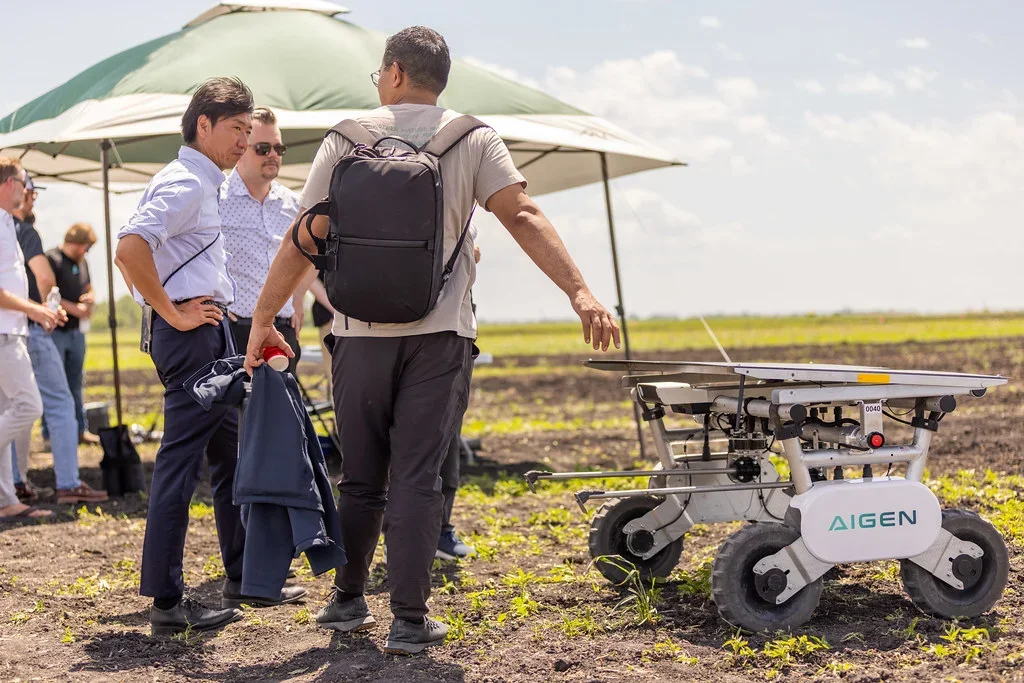Our Office: 4100 32nd Ave. S. Fargo, ND 58104
Grand Farm: Furthering the breadbasket of the world

It’s no secret that farmers are the basis of our world and fuel success for individuals and organizations across the globe.
Growers are the backbone, and the Red River Valley is the breadbasket…and Grand Farm is the vehicle that can connect the two to solve the biggest problems in agriculture through AgTech and innovation.
“Grand Farm is built around the space between growers, folks in agriculture, and research institutions who do amazing things in our region,” Grand Farm Co-founder (alongside Brian Carroll)and Executive Director Dr. William Aderholdt said.
To understand Grand Farm, one must first understand the ecosystem that the nonprofit sits in.
“There is an agricultural ecosystem that includes growers, retailers, cooperatives, and utilities. They all have their place in how agriculture currently functions, and each player has opportunities and challenges,” Aderholdt said. “It’s our job to connect them with innovation ecosystems to work toward solving those challenges.”
Aderholdt, who holds a master’s and a doctorate from Montana State University, references startups, corporations, and research institutions as potential members of innovation ecosystems that he and his team work with to problem-solve alongside those in the agriculture ecosystem. While technology is the driving force behind connecting the two worlds, a foundation is built through human relationships and connections.
“We meet with these groups (in the agriculture ecosystem), and we better understand them,” Aderholdt said. “We tour their sites, whether that be a farm or fertilizer distribution point, and ask a ton of questions to best understand the operation and how technology can play in.”
After garnering an understanding, Aderholt and his team work to expose challenges and opportunities by bringing in folks from external ecosystems.
“We ask them (those in innovative ecosystems) ‘Are you solving these problems? Could you be solving these, and how would you like to solve them?’” he said.
The final step? Bringing both parties to Grand Farm’s pristine 25,000-square-foot Innovation Campus just west of Casselton, North Dakota. Debuting in June 2024, the campus spans 140 acres and is designed for growers, startups, corporations, researchers, and education groups to collaborate on technology.
“While we do plenty of matchmaking at conferences and events, the innovation campus has test plots and an environment that allows us to test in real life to see how things work and physically spot challenges,” Aderholdt said. “That physical connection and conversation is so important.”
It also creates trust, something that is vital to decreasing the time to market for solutions.
“We want relevant solutions in the hands of growers,” Aderholdt said. “We want people to trust the solutions going out, and it’s our hope to get them out. That’s what we’ve built over the past five years.”
Ag through entrepreneurship
Inspired by the strong sense of community and a zest for new adventures in 2019, Aderholdt and his wife decided it was time to move from the Treasure State to the Peace Garden State.
“We were actually running the Fargo Marathon together alongside the beautiful trees on Albrecht Drive, and I looked at my wife and said, ‘We’re moving here,’”’ he recalled.
Once roots had been settled, Aderholdt found himself at 1 Million Cups (now known as StartupBREW), the Red River Valley’s premier entrepreneurial programming run by Emerging Prairie (which is Grand Farm’s parent organization).
“I was trying to figure out what to do after wrapping up my Ph.D,” he said. “From my military background, I wanted to be the first one there (to the event) and the last to leave.”
Sure enough, Brian Carroll, who serves as Grand Farm’s Chief Information Officer and Co-founder alongside Aderholdt, had the same mindset. The two conviened and the rest is history.
Five years later, Aderholt is confident that Grand Farm has and will continue to change the world for the better.
“We just finished a third agricultural revolution and increased the ability to be efficient in food production on a production scale to feed nearly 9 billion people in the world,” he said. “Now we’re beginning to look at what technology can bring to us as we prepare for the fourth agricultural revolution and how it can change things. There’s no better place to do it than here.”
